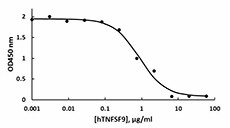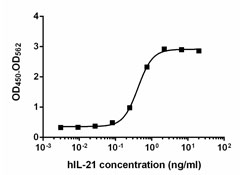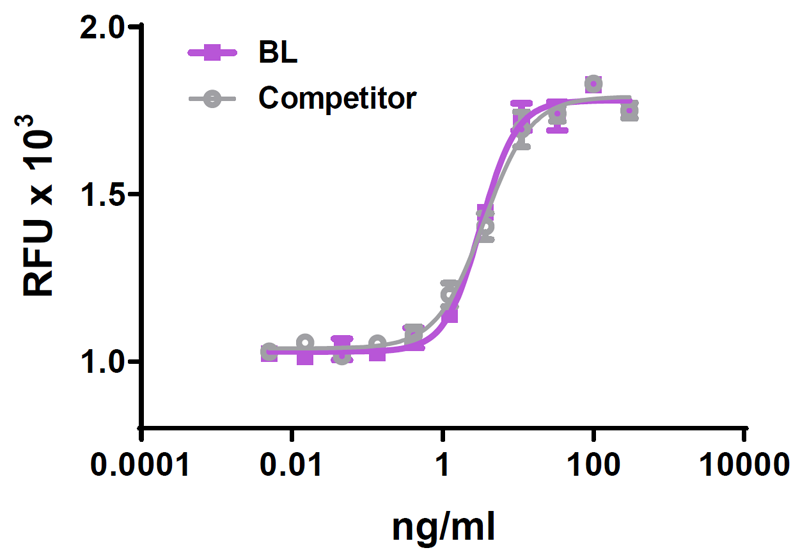- Regulatory Status
- RUO
- Other Names
- CD137L, 4-1BB-L, 4-1BBL, 41BBL, 4-1BB Ligand, 41BB Ligand
- Ave. Rating
- Submit a Review
- Product Citations
- publications

-

The recombinant human TNFSF9, when immobilized with anti-CD3 antibody, is able to inhibit the secretion of IFN-γ by activated human T cells in a dose dependent manner. The ED50 is 0.4 - 4.0 µg/ml. The results may vary depending on human donors.
TNFSF9, also known as 4-1BBL and CD137L, is a type II transmembrane glycoprotein that belongs to the TNF superfamily. This protein is mainly expressed on antigen presenting cells (APC), and on B lymphocytes particularly. The interaction between TNFSF9 and its receptor, CD137, which is mainly expressed on T cells, leads to the activation of cytotoxic T cells. In addition, TNFSF9-CD137 interaction can reactivate anergic T lymphocytes and induce T cell proliferation. This molecule plays a role in optimal CD8 T cell response. Interestingly, it appears that TNFSF9 is able to act as a costimulatory molecule without the engagement of other costimulatory molecules such as CD28. TNFSF9 signaling on T cells has also been shown to limit T cell activation. CD137L is upregulated in peripheral CD14+ monocytes of chronic hepatitis B patients and is associated with liver cirrhosis. Human TNFSF9 shares 36% of its amino acid sequence with its murine counterpart. Mice deficient of TNFSF9 are susceptible to develop B-cell lymphomas.
Product DetailsProduct Details
- Source
- Human TNFSF9, amino acids (Arg71-Glu254) (Accession# NP_003802), was expressed in 293E cells with a N-terminal His tag.
- Molecular Mass
- The 193 amino acid recombinant protein has a predicted molecular mass of approximately 20.5 kD. The protein migrates at about 22 kD in DTT-reducing conditions by SDS-PAGE. The predicted N-terminal amino acid is His.
- Purity
- >97%, as determined by Coomassie stained SDS-PAGE.
- Formulation
- 0.22 µm filtered protein solution is in PBS, pH 7.2.
- Endotoxin Level
- Less than 1.0 EU per µg of protein as determined by the LAL method.
- Concentration
- 10 and 25 µg sizes are bottled at 200 µg/mL. 100 µg size and larger sizes are lot-specific and bottled at the concentration indicated on the vial. To obtain lot-specific concentration and expiration, please enter the lot number in our Certificate of Analysis online tool.
- Storage & Handling
- Unopened vial can be stored between 2°C and 8°C for up to 2 weeks, at -20°C for up to six months, or at -70°C or colder until the expiration date. For maximum results, quick spin vial prior to opening. The protein can be aliquoted and stored at -20°C or colder. Stock solutions can also be prepared at 50 - 100 µg/mL in appropriate sterile buffer, carrier protein such as 0.2 - 1% BSA or HSA can be added when preparing the stock solution. Aliquots can be stored between 2°C and 8°C for up to one week and stored at -20°C or colder for up to 3 months. Avoid repeated freeze/thaw cycles.
- Activity
- Human TNFSF9, when immobilized with anti-CD3 antibody, is able to inhibit IFN-γ secretion in human T cells in a dose-dependent manner with an ED50 of 0.4 - 4.0 µg/mL. Results may vary depending on human donors.
- Application
-
Bioassay
- Application Notes
-
BioLegend carrier-free recombinant proteins provided in liquid format are shipped on blue-ice. Our comparison testing data indicates that when handled and stored as recommended, the liquid format has equal or better stability and shelf-life compared to commercially available lyophilized proteins after reconstitution. Our liquid proteins are verified in-house to maintain activity after shipping on blue ice and are backed by our 100% satisfaction guarantee. If you have any concerns, contact us at tech@biolegend.com.
Antigen Details
- Structure
- Monomer.
- Distribution
-
Constitutively expressed on a fraction of dendritic cells (DCs). Inducible on activated monocytes, macrophages, B cells, a small fraction of T cells, epithelial, and endothelial cells.
- Function
- TNFSF9 plays roles in cytotoxic T cell activation, T cell proliferation, and apoptosis.
- Interaction
- Activated T cells, natural killer cells (NK), macrophages, and dedritic cells.
- Ligand/Receptor
- CD137.
- Bioactivity
- TNFSF9 immobilized with anti-CD3 antibody is able to inhibit the secretion of IFN-γ by activated T cells.
- Biology Area
- Immunology, Costimulatory Molecules
- Molecular Family
- CD Molecules, Immune Checkpoint Receptors, Soluble Receptors
- Antigen References
-
1. Vinay DS and Kwon BS. 1998. Semin. Immunol. 10:481.
2. Watts TH. 2005. Annu. Rev. Immunol. 23:23.
3. Pollok KE, et al. 1994. Eur. J. Immunol. 24:367.
4. Wang J, et al. 2010. J. Immunol. 185:7654.
5. Eun SY, et al. 2014. J. Immunol. 194:134.
6. Spencer AJ, et al. 2014. PLoS One 9:e105520.
7. Locatelli F. 2009. Blood 114:2208. - Gene ID
- 8744 View all products for this Gene ID
- UniProt
- View information about TNFSF9 on UniProt.org
Related Pages & Pathways
Pages
Related FAQs
- Why choose BioLegend recombinant proteins?
-
• Each lot of product is quality-tested for bioactivity as indicated on the data sheet.
• Greater than 95% Purity or higher, tested on every lot of product.
• 100% Satisfaction Guarantee for quality performance, stability, and consistency.
• Ready-to-use liquid format saves time and reduces challenges associated with reconstitution.
• Bulk and customization available. Contact us.
• Learn more about our Recombinant Proteins. - How does the activity of your recombinant proteins compare to competitors?
-
We quality control each and every lot of recombinant protein. Not only do we check its bioactivity, but we also compare it against other commercially available recombinant proteins. We make sure each recombinant protein’s activity is at least as good as or better than the competition’s. In order to provide you with the best possible product, we ensure that our testing process is rigorous and thorough. If you’re curious and eager to make the switch to BioLegend recombinants, contact your sales representative today!
- What is the specific activity or ED50 of my recombinant protein?
-
The specific activity range of the protein is indicated on the product datasheets. Because the exact activity values on a per unit basis can largely fluctuate depending on a number of factors, including the nature of the assay, cell density, age of cells/passage number, culture media used, and end user technique, the specific activity is best defined as a range and we guarantee the specific activity of all our lots will be within the range indicated on the datasheet. Please note this only applies to recombinants labeled for use in bioassays. ELISA standard recombinant proteins are not recommended for bioassay usage as they are not tested for these applications.
- Have your recombinants been tested for stability?
-
Our testing shows that the recombinant proteins are able to withstand room temperature for a week without losing activity. In addition the recombinant proteins were also found to withstand four cycles of freeze and thaw without losing activity.
- Does specific activity of a recombinant protein vary between lots?
-
Specific activity will vary for each lot and for the type of experiment that is done to validate it, but all passed lots will have activity within the established ED50 range for the product and we guarantee that our products will have lot-to-lot consistency. Please conduct an experiment-specific validation to find the optimal ED50 for your system.
- How do you convert activity as an ED50 in ng/ml to a specific activity in Units/mg?
-
Use formula Specific activity (Units/mg) = 10^6/ ED50 (ng/mL)
 Login / Register
Login / Register 












Follow Us